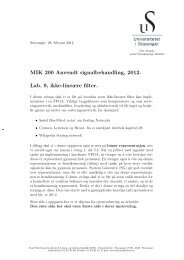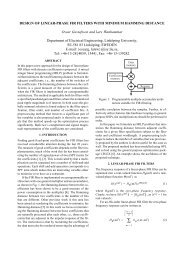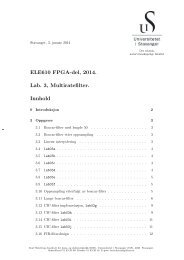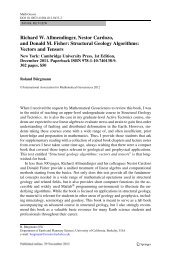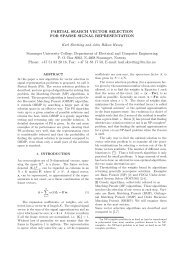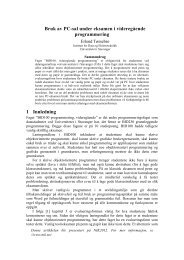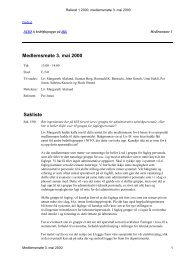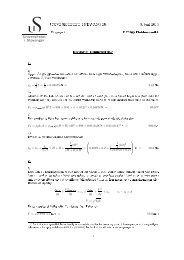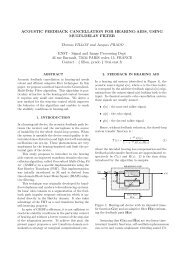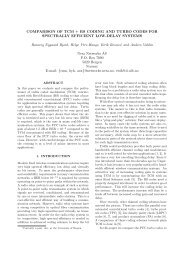- Page 1: Lecture NotesCourse ÅMA 190Numeric
- Page 6 and 7: 13.8.4 Inverse linear interpolation
- Page 8 and 9: AbstractNumerical analysts study th
- Page 10 and 11: 1.1.1 Two standard inequalitiesLet
- Page 12 and 13: Example 1.1.3 Examples with s = 3:N
- Page 14 and 15: and the relative condition number b
- Page 16 and 17: This general example may be special
- Page 18 and 19: Theorem 1.5.2 Let A be a square mat
- Page 20 and 21: 1.6.2 Arithmetic sequencen(n − 1)
- Page 22 and 23: 1.6.7 Taylor’s formulaWe derive T
- Page 24 and 25: )c)becauselimx→0x 2e x − 1 −
- Page 26 and 27: 1.7.7 Locating rootsPutShow that th
- Page 28 and 29: We next construct the general solut
- Page 32 and 33: Example 2.3.5 Consider a computer w
- Page 34 and 35: We now determine c such that 2 + 3c
- Page 36 and 37: e recorded) If there is no such col
- Page 38 and 39: the left hand side and the right ha
- Page 40 and 41: Chapter 4Iterative methods for Ax =
- Page 42 and 43: or, in matrix form with the coeffic
- Page 44 and 45: Chapter 5Least squares fit5.1 Norma
- Page 46 and 47: c 1,4 is the product of the first a
- Page 48 and 49: PutandL i (t) =P (t) =5∏(t − t
- Page 50 and 51: 6.2 On the choice of nodesIf t i in
- Page 52 and 53: k arguments:f[t i1 , . . . , t ik ]
- Page 54 and 55: Q(x) = 4.6 − 0.8(x + 2) + 0.6x(x
- Page 56 and 57: a relative error bound if x ≠ 0.
- Page 58 and 59: 7.2.2 MultiplicationPutwheres = x 1
- Page 60 and 61: We now assume that f has a continuo
- Page 62 and 63: functional values. Let s ∗ be an
- Page 64 and 65: 7.5.2 Example: additionLetWe then h
- Page 66 and 67: Chapter 8Numerical treatment ofnonl
- Page 68 and 69: 8.3 Determination of approximate ro
- Page 70 and 71: Proof:The case n = 0 is the stateme
- Page 72 and 73: 8.6 The fixed-point methodTo use th
- Page 74 and 75: Chapter 9On approximation offunctio
- Page 76 and 77: 9.1.3 The square rootTo find √ a,
- Page 78 and 79: which is achieved forTo gett i = 1/
- Page 80 and 81:
whereF (h, w) = h∞∑n=−∞e iw
- Page 82 and 83:
Proof PutThen we haveandM n = supr>
- Page 84 and 85:
10.3 Numerical treatment of rapidly
- Page 86 and 87:
n a n−1 s n1 1.00000 1.000002 −
- Page 88 and 89:
phenomenon we needDefinition 10.4.1
- Page 90 and 91:
a r and b r are given bya r = exp(
- Page 92 and 93:
11.2 Constructing the trapezoidal r
- Page 94 and 95:
In the case of (11.2) it is suffici
- Page 96 and 97:
should give exact results for all l
- Page 98 and 99:
h=0.2 :f(0) + f(1.6)T (0.2) = 0.2
- Page 100 and 101:
h=0.5 :T (0.5) = 0.5 · f(0) + f(0.
- Page 102 and 103:
A system of ordinary differential e
- Page 104 and 105:
12.3.1 Euler’s methodx r+1 = x r
- Page 106 and 107:
It is directly verified that the so
- Page 108 and 109:
1.00 1.246834041.00 1.246818301.00
- Page 110 and 111:
13.1.3 Stirling’s formula13.1.4 B
- Page 112 and 113:
Power expansions for some elementar
- Page 114 and 115:
TranspositionThenA ∈ R n×m , B =
- Page 116 and 117:
13.5 Least squares solution of line
- Page 118 and 119:
Let f be a function which may be di
- Page 120 and 121:
13.9 Systems of nonlinear equations
- Page 122 and 123:
may be writtenx(t) = x h (t) + x p
- Page 124 and 125:
Chapter 14Laboratory exercises andc
- Page 126 and 127:
Start with x 0 = 1b) Use the bisect
- Page 128 and 129:
14.7 Case studies14.8 Evaluation of
- Page 130 and 131:
n piv,sing nonpiv,sing piv,dbl nonp
- Page 132 and 133:
We put c = 100 + u and solve the pr
- Page 134 and 135:
and hence we may consider minimisin
- Page 136 and 137:
x f(x)−1.0 0.3679−0.5 0.6065 .0
- Page 138 and 139:
14.12 Numerical integration problem
- Page 140 and 141:
14.12.5 Integrand with integrable s



